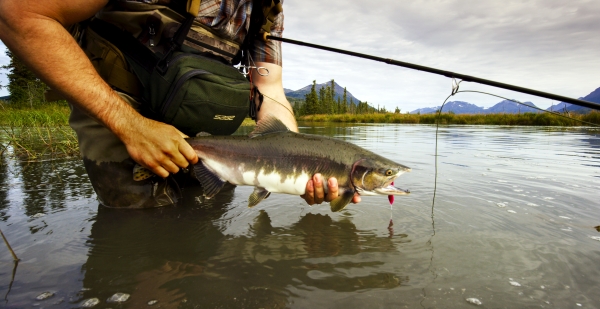
Kenai National Wildlife Refuge contains ponds, thousands of lakes, several major rivers and numerous streams. Estuarine areas limited to the remote Chickaloon River flats on Turnagain Arm of Cook Inlet. Rivers include the Russian and the upper Kenai. Tustumena and Skilak lakes, at 73,000 and 25,000 acres, respectively, are among the largest in Alaska. There is good salmon fishing in the Kasilof, Swanson, Russian and Kenai rivers. Fishing is generally year-round, with the exception of some salmon.
Kenai River
The turquoise waters of the Kenai River — Alaska’s premier fishing destination — originate from multiple glaciers and flow over 80 miles westward from Kenai Lake across the Kenai Peninsula to Cook Inlet. This river draws visitors from all over the world and boasts the largest sport fisheries for wild, self-sustaining Coho, Chinook, and Sockeye Salmon in the state. The Kenai River holds the world record for king and red salmon taken by rod and reel. Species available include silver, pink, king and red salmon, rainbow trout, Arctic char, Dolly Varden, lake trout, steelhead, kokanee and grayling. Whether fishing from a drift or power boat or walking the banks fly fishing, there are a variety of guided and self-guided ways to experience the Kenai River (there are boating restrictions).
Resident Rainbow Trout and Dolly Varden char provide excellent year-round opportunities. Salmon attract anglers from May to October. The largest of the Pacific salmon, Chinook (Kings) kick off the salmon season May. At just shy of 100 pounds, the biggest ever landed with rod and reel was a Kenai River King. Conserving this unique strain of Chinook is becoming precedent as many anglers now prefer to catch and release and tell the tale. To complement the spectacular opportunity to catch the next world record Chinook, hundreds of thousands to sometimes millions of Sockeye Salmon return to spawn during Alaska’s summer months. Anglers flock from all over the world to catch these feisty fish. Don’t be fooled into thinking the end of the salmon season coincides with the end of summer—not so! The shorter days and cooler temperatures mark the beginning of Coho Salmon season. Returning as early as late July, these aggressive fish will keep you fishing into late fall and early winter. Die-hard fishers seeking nonstop action should fish the Kenai during even years when millions of Pink Salmon return in late July and August.
Know before you go
Fishing on the Kenai National Wildlife Refuge is a great angling challenge as each body of water has its own unique fish ecology and regulations. Obtain a current copy of the Sport Fishing Regulations Summary for Southcentral Alaska and keep it handy while fishing. The key to using this booklet is to first locate where you want to fish, and then follow the regulations that apply to each specific area. You must purchase a valid sport fishing license if you are age 16 or older. These are available at local sporting goods and grocery stores. They can also be purchased online from the Alaska Department of Fish and Game. For information on the status of fish concentrations and emergency closures contact the ADF&G Soldotna Office.
Fishing Away From the Crowds
Good areas for quiet fishing near the road system are found in small lakes such as Lower Ohmer, Watson, Kelly, Petersen, Forest, Dolly Varden, Rainbow, Paddle, and many areas of the Swan Lake and Swanson River canoe systems. Fishing from a canoe or small inflatable boat is highly recommended to successfully fish for rainbow trout in these waters. One of the few areas to fish for grayling is Lower Fuller Lake, a steep 1.5-mile hike from mile 57 of the Sterling Highway. Hike the Fisherman’s Trail upstream from the Forest Service’s Russian River Campground, at mile 52.8 of the Sterling Highway, for a less crowded red salmon fishing experience.
Fishing in Bear Country
- If a bear approaches you while you have a fish on the line, cut the line and leave the area.
- Fish remains attract bears. Toss all fish waste into deep, fast-moving water. Do not put in dumpsters or on shore. Cut fish carcasses into small pieces so the water current can carry and disperse them more easily.
- When you carry fish out, store them in sealed plastic garbage bags to decrease odors that could attract bears on paths and trails.
- Store all food, bait, line and tackle, fishy clothes, and garbage in bear-proof containers in your vehicle.
- Avoid fishing during times of low visibility (dawn, dusk, and at night) to prevent bear encounters.
- Always keep your dog on a leash and under control to prevent negative bear encounters.
Maps
Downloadable PDF maps are available here: Kenai National Wildlife Refuge Trail Maps, Kenai Peninsula Lake Bathymetry Maps
